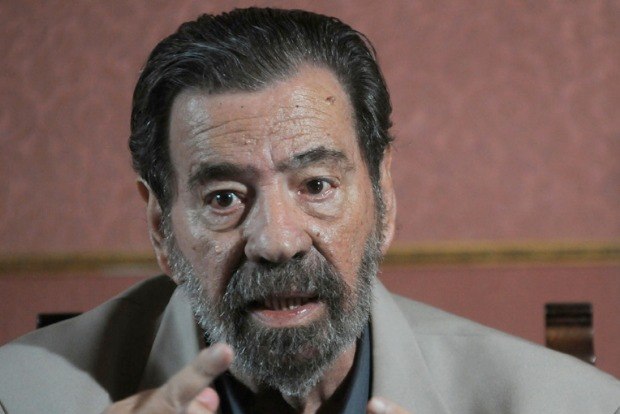Paulo Malhães
Paulo Malhães was a Brazilian Army officer who died during a home invasion and robbery.[1][2] Shortly before his death Malhães had acknowledged he had tortured and killed dissidents during the Brazilian military dictatorship, and was unapologetic for doing so.[3][4][5][6][7] According to the South China Morning Post his death was suspected to have been an act of retaliation, but his autopsy demonstrated that he died of a heart attack.
Malhães first spoke about serving as a torturer in 2012,to the Truth Commission, forty years after he had been assigned to manage a safehouse in Petrópolis, colloquially known as Casa da Morte—the "house of death"—where torture was routine.[4] His work in 1970-1972 consisted of torture and interrogation of suspected political opponents of the regime. According to Malhães, the nominal goal of the activities in the safe house was to convince the suspects to agree to serve as double agents. According to Malhães, in addition to ending their torture those suspects who agreed to serve as double agents would receive clandestine payments as incentives. However, the only suspect he described agreeing to serve as a double agent, Inês Etienne Romeu, was later deemed to have been insincere, and was imprisoned for a further eight years. Details of the activities at the "house of death" was the safehouse was colloquially known were first confirmed in her 1979 memoirs. At least 22 suspects held in the house died.
Malhães acknowledged that Carlos Alberto Soares de Freitas, a high profile regime opponent who had disappeared, and was never been seen again, had been held in the house.[4] But he claimed that former Congressman Rubens Paiva must have been held elsewhere.
References
- ↑ "Brazilian Ex-Soldier Who Admitted Torture Is Killed". New York Times. 2014-04-26. p. A12. Archived from the original on 2014-04-27. https://web.archive.org/web/20140427035136/http://www.nytimes.com/2014/04/27/world/americas/brazilian-ex-soldier-who-admitted-torture-is-killed.html. Retrieved 2014-05-01. "A former army colonel who admitted that he tortured and killed political prisoners during Brazil’s 1964-1985 military dictatorship was killed in his home outside Rio de Janeiro, the police told local news media on Saturday."
- ↑ "Brazilian military rule torturer Paulo Malhaes found dead". BBC News. 2014-04-25. Archived from the original on 2014-05-01. https://web.archive.org/web/20140501145158/http://www.bbc.com/news/world-latin-america-27166848. Retrieved 2014-05-01. "Last month, he said he never regretted killing "as many people as necessary" and tortured "many" prisoners."
- ↑ "Autopsy scotches rumours of murder in case of Paulo Malhaes in Brazil". South China Morning Post. 2014-04-28. Archived from the original on 2014-05-02. https://web.archive.org/web/20140502022101/http://www.scmp.com/news/world/article/1498438/autopsy-scotches-rumours-murder-case-paulo-malhaes-brazil. Retrieved 2014-05-01. "A retired Brazilian colonel who confessed to torturing and killing detainees decades ago has died from a heart attack during a break-in at his home, according to an autopsy report that has debunked murder conspiracy theories."
- ↑ 4.0 4.1 4.2 Chico Otavio, Juliana Dal Piva, Marcelo Remigio (2012-06-23). "Torturador conta rotina da Casa da Morte em Petrópolis: Tenente-coronel reformado fala sobre casa onde 22 pessoas podem ter sido executadas [Torturer routine account of the House of Death in Petropolis: Retired Lieutenant Colonel talks about house where 22 people may have been executed]" (in Portuguese). O Globo. Archived from the original on 2014-04-27. https://web.archive.org/web/20140427092429/http://oglobo.globo.com/pais/torturador-conta-rotina-da-casa-da-morte-em-petropolis-5300155. Retrieved 2014-05-29.
- ↑ Rachel Dry (2014-12-10). "A máquina de escrever que evitava torturas [The typewriter that prevented torture]" (in Portugese). Sao Paolo, Brazil: El Pais (Brazil). Archived from the original on 2015-01-07. https://web.archive.org/web/20150107140531/http://brasil.elpais.com/brasil/2014/12/10/politica/1418208799_440318.html.
- ↑ "Em vídeo, ex-delegado do DOPS pede que coronel Malhães vá à Comissão da Verdade [In the video, former delegate of DOPS asks Colonel Malhães go to the Truth Commission]" (in Portuguese). Último Segundo. 2012-06-24. http://ultimosegundo.ig.com.br/politica/2012-06-24/em-video-ex-delegado-do-dops-pede-que-coronel-malhaes-va-a-comissao-da-verdade.html. Retrieved 2014-05-01.
- ↑ Euler de França Belém. "Aparece o carcereiro da Casa da Morte de Petrópolis. Ele estuprou Inês Etienne Romeu [Appears the jailer of the House of Death of Petropolis. He raped Ines Etienne Romeu]" (in Portugese). Jornal Opção. Archived from the original on 2014-12-04. https://web.archive.org/web/20141204150202/http://www.jornalopcao.com.br/colunas-e-blogs/imprensa/aparece-o-carcereiro-da-casa-da-morte-de-petropolis-ele-estuprou-ines-etienne-romeu-20393/. Retrieved 2015-01-07. "A Casa da Morte de Petrópolis é a micro Auschwitz da ditadura civil-militar do Brasil. Lá pelo menos vinte integrantes da esquerda foram assassinados e esquartejados por militares. Poucos do que atuavam na residência foram identificados. Sabe-se que os coronéis Paulo Malhães (codinome Pablo) — pouco antes de ser assassinado, admitiu ter sido o organizador-operador do centro de tortura e morte — e Freddie Perdigão (dr. Nagib) atuaram na Casa da Morte."
